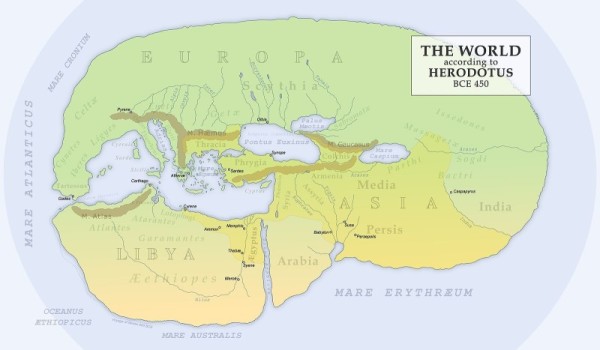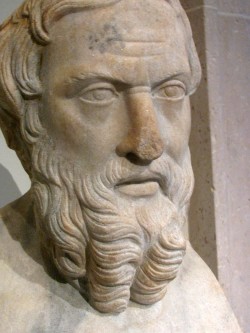Religeous and burial customs of the Scythians (north of the Black Sea). – From book 4.

Translated by Lord Macaulay — our special project presenting the complete Herodotus with URLs for all of those people, places, events, and things which baffles and discourages modern readers.
Previously on Herodotus
69. They put them to death accordingly in the following manner:—first they fill a wagon with brushwood and yoke oxen to it; then having bound the feet of the diviners and tied their hands behind them and stopped their mouths with gags, they fasten them down in the middle of the brushwood, and having set fire to it they scare the oxen and let them go: and often the oxen are burnt to death together with the diviners, and often they escape after being scorched, when the pole to which they are fastened has been burnt: and they burn the diviners in the manner described for other causes also, calling them false prophets. Now when the king puts any to death, he does not leave alive their sons either, but he puts to death all the males, not doing any hurt to the females.
70. In the following manner the Scythians make oaths to whomsoever they make them:—they pour wine into a great earthenware cup and mingle with it blood of those who are taking the oath to one another, either making a prick with an awl or cutting with a dagger a little way into their body, and then they dip into the cup a sword and arrows and a battle-axe and a javelin; and having done this, they invoke many curses on the breaker of the oath, and afterwards they drink it off, both they who are making the oath and the most honorable of their company.
71. The burial-place of the kings is in the land of the Gerrians, the place up to which the Borysthenes is navigable. In this place, when their king has died, they make a large square excavation in the earth; and when they have made this ready, they take up the corpse (the body being covered over with wax and the belly ripped up and cleansed, and then sewn together again, after it has been filled with kyperos cut up and spices and parsley-seed and anise), and they convey it in a wagon to another nation. Then those who receive the corpse thus conveyed to them do the same as the Royal Scythians, that is they cut off a part of their ear and shave their hair round about and cut themselves all over the arms and tear their forehead and nose and pass arrows through their left hand. Thence they convey in the wagon the corpse of the king to another of the nations over whom they rule; and they to whom they came before accompany them: and when they have gone round to all conveying the corpse, then they are in the land of the Gerrians, who have their settlements furthest away of all the nations over whom they rule, and they have reached the spot where the burial place is. After that, having placed the corpse in the tomb upon a bed of leaves, they stick spears along on this side and that of the corpse and stretch pieces of wood over them, and then they cover the place in with matting. Then they strangle and bury in the remaining space of the tomb one of the king’s mistresses, his cup-bearer, his cook, his horse-keeper, his attendant, and his bearer of messages, and also horses, and a first portion of all things else, and cups of gold; for silver they do not use at all, nor yet bronze. Having thus done they all join together to pile up a great mound, vying with one another and zealously endeavouring to make it as large as possible.

CC BY-SA 2.0 image from Wikipedia.
72. Afterwards, when the year comes round again, they do as follows:—they take the most capable of the remaining servants,—and these are native Scythians, for those serve him whom the king himself commands to do so, and his servants are not bought for money,—of these attendants then they strangle fifty and also fifty of the finest horses; and when they have taken out their bowels and cleansed the belly, they fill it with chaff and sew it together again. Then they set the half of a wheel upon two stakes with the hollow side upwards, and the other half of the wheel upon other two stakes, and in this manner they fix a number of these; and after this they run thick stakes through the length of the horses as far as the necks, and they mount them upon the wheels; and the front pieces of wheel support the shoulders of the horses, while those behind bear up their bellies, going by the side of the thighs; and both front and hind legs hang in the air. On the horses they put bridles and bits, and stretch the bridles tight in front of them and then tie them up to pegs: and of the fifty young men who have been strangled they mount each one upon his horse, having first run a straight stake through each body along by the spine up to the neck; and a part of this stake projects below, which they fasten into a socket made in the other stake that runs through the horse. Having set horsemen such as I have described in a circle round the tomb, they then ride away.
73. Thus they bury their kings; but as for the other Scythians, when they die their nearest relations carry them round laid in wagons to their friends in succession; and of them each one when he receives the body entertains those who accompany it, and before the corpse they serve up of all things about the same quantity as before the others. Thus private persons are carried about for forty days, and then they are buried: and after burying them the Scythians cleanse themselves in the following way:—they soap their heads and wash them well, and then, for their body, they set up three stakes leaning towards one another and about them they stretch woolen felt coverings, and when they have closed them as much as possible they throw stones heated red-hot into a basin placed in the middle of the stakes and the felt coverings.
– Herodotus, Book IV
| <—Previous | Master List | Next—> |
Herodotus made his living by being interesting. In a world where most people did not read and could not afford to buy a book even if they could, they would pay to listen to Herodotus recite from his books. They would not pay to be bored. In that world, the names that populate his stories would have some general familiarity to his audience. Their obscurity to us is a barrier that this series seeks to break down.
MORE INFORMATION
MAP LIBRARY
Because of lack of detail in maps as embedded images, we are providing links instead, enabling readers to view them full screen.

Leave a Reply
You must be logged in to post a comment.